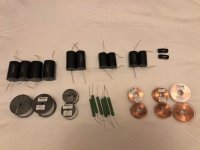The important thing is what the filters do to your speaker. Knowing what to do here is the more challenging part of a crossover as it goes right back to your acoustic design.I know active crossovers are better,
I get the same results between active and passive (and other) types because I ask them to do the same thing.
Software certainly won't tell you what to do, but if you already know that then software will help you to good results.newvirus2008 said:Software alone doesn't work well because any simulation is only as good as the models it uses.
Well, I would not say that an active crossover is always better, but they definitely are more convenient, especially when multi-way meets multi-channel. However, in a regular stereo setup, passive crossovers are simpler and make more sense.
Yes DrZoidberg, I suggest you get some software for your crossovers as well, that's always better.
AllenB said:Software certainly won't tell you what to do, but if you already know that then software will help you to good results.
Yes DrZoidberg, I suggest you get some software for your crossovers as well, that's always better.
So, i have decided, i am going with Phi design.
Now i have a questions regarding XO
I cant find desired cap / coil values, can i wire them in parallel/serial to get what i need, it wont affect much right ?
Is there much difference between MKT and MKT-A caps ?
If i have a coil with desired inductance but slightly fatter wire is that ok ? Design say 1,18mm, but one i found have 1,32mm wire for L5.
L3 is suppose to be 1.2mh, but i can only get 1.5mh or 1.36mh, will this affect much ?
And last one, L1 is for correction, so i can buy cheaper ferrite core coil ?

FYI there is typo in component list, in diagram there is also C6 @ 82uF
Now i have a questions regarding XO
I cant find desired cap / coil values, can i wire them in parallel/serial to get what i need, it wont affect much right ?
Is there much difference between MKT and MKT-A caps ?
If i have a coil with desired inductance but slightly fatter wire is that ok ? Design say 1,18mm, but one i found have 1,32mm wire for L5.
L3 is suppose to be 1.2mh, but i can only get 1.5mh or 1.36mh, will this affect much ?
And last one, L1 is for correction, so i can buy cheaper ferrite core coil ?

FYI there is typo in component list, in diagram there is also C6 @ 82uF
Last edited:
Here is the link for pdf of schematics for Phi
Pages 35-40
Klang Und Ton Magazin Juni Juli No 04 2013 - Free Download PDF
Pages 35-40
Klang Und Ton Magazin Juni Juli No 04 2013 - Free Download PDF
1) I cant find desired cap / coil values, can i wire them in parallel/serial to get what i need, it wont affect much right ?
2) Is there much difference between MKT and MKT-A caps ?
3) If i have a coil with desired inductance but slightly fatter wire is that ok ? Design say 1,18mm, but one i found have 1,32mm wire for L5.
4) L3 is suppose to be 1.2mh, but i can only get 1.5mh or 1.36mh, will this affect much ?
5)And last one, L1 is for correction, so i can buy cheaper ferrite core coil ?
1) Yes, but mostly only for capacitors. Try to avoid using multiple inductors for the same part. In case a different value is necessary, get a slightly higher value and bring back the inductance by reducing few turns (calculation needed). However, if using steel / ferrite cored inductors, never increase turns to increase inductance, as it reduces the saturation current limit.
2) Between polyester and polypropylene, prefer the latter as far as possible. Also, axial capacitors allow easier and simpler electrical connections.
3) A bigger wire is perfectly OK. However, it's better if the difference between their DCRs is adjusted for, by using a non-inductive series resistor of sufficient wattage, so as to maintain the truthfulness of your duplication process.
4) Same as in (1).
5) In general, get the same kind of components and lay them out in the same manner as mentioned in the design.
All the best.
Last edited:
1) Yes, but mostly only for capacitors. Try to avoid using multiple inductors for the same part. In case a different value is necessary, get a slightly higher value and bring back the inductance by reducing few turns (calculation needed). However, if using steel / ferrite cored inductors, never increase turns to increase inductance, as it reduces the saturation current limit.
2) Between polyester and polypropylene, prefer the latter as far as possible. Also, axial capacitors allow easier and simpler electrical connections.
3) A bigger wire is perfectly OK. However, it's better if the difference between their DCRs is adjusted for, by using a non-inductive series resistor of sufficient wattage, so as to maintain the truthfulness of your duplication process.
4) Same as in (1).
5) In general, get the same kind of components and lay them out in the same manner as mentioned in the design.
All the best.
Thx Virus, helped alot
Hi all,
Im back and i bought xo components and array speakers. Almost all is prepared.
Have few thoughts regarding cabinet design and damping.
Should i only reinforce cabinet on outer edge or have couple beams across baffle for extra strength.
Also what would be a diy el cheapo for damping ? Use cotton, wool, thermal isolation padding ? Maybe what is a substitute for Twaron ?
One more thing, the way tweeters in array are wired, can i wire them 6 in row parallel ? I dont quite understand if they are wired like this on purpose or they didnt want to print 6 speaker in row.
Im back and i bought xo components and array speakers. Almost all is prepared.
Have few thoughts regarding cabinet design and damping.
Should i only reinforce cabinet on outer edge or have couple beams across baffle for extra strength.
Also what would be a diy el cheapo for damping ? Use cotton, wool, thermal isolation padding ? Maybe what is a substitute for Twaron ?
One more thing, the way tweeters in array are wired, can i wire them 6 in row parallel ? I dont quite understand if they are wired like this on purpose or they didnt want to print 6 speaker in row.
Attachments
Fibreglass / glasswool, rockwool, dacron etc. are regularly available materials that are frequently used for damping purposes.
However, more importantly, these are all hazardous materials, so be sure to wear gloves, a mask (must cover nose) and glasses while handling them. Be as quick (and clean) as possible with the cutting by having all measurements ready.
It is also a good idea to wrap the damping in thin tissue paper before glueing them, to prevent any loose fibres from flying around (in due course). Do not breathe in the fibres, under any circumstances.
Those tweeters are wired so as to present a particular (2/3) impedance to the network. Wiring them in parallel would change a lot of things, so it may be best to leave them alone.
However, more importantly, these are all hazardous materials, so be sure to wear gloves, a mask (must cover nose) and glasses while handling them. Be as quick (and clean) as possible with the cutting by having all measurements ready.
It is also a good idea to wrap the damping in thin tissue paper before glueing them, to prevent any loose fibres from flying around (in due course). Do not breathe in the fibres, under any circumstances.
Those tweeters are wired so as to present a particular (2/3) impedance to the network. Wiring them in parallel would change a lot of things, so it may be best to leave them alone.
Last edited:
I have some old glasswool, but i would rather avoid lose toxic material. with that amount of air in cabinets and that big bass reflex hole, its bound to fly off.Fibreglass / glasswool, rockwool, dacron etc. are regularly available materials that are frequently used for damping purposes.
However, more importantly, these are all hazardous materials, so be sure to wear gloves, a mask (must cover nose) and glasses while handling them. Be as quick (and clean) as possible with the cutting by having all measurements ready.
It is also a good idea to wrap the damping in thin tissue paper before glueing them, to prevent any loose fibres from flying around (in due course). Do not breathe in the fibres, under any circumstances.
Any non toxic variants, like cotton for makeup.
In design materials they used couple types.
Like this Sonofil Polyester 400x500x30 MM white
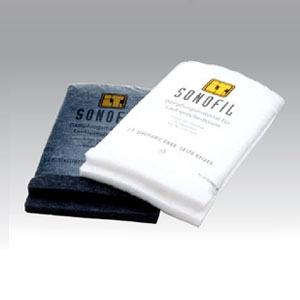
And some Damping material. 1000x500x20mm
From my understanding damping material is to be padded inside the cabinet and Sonnofill and Fiberglass material for the array column.
Im thinking of building array column out of wood entirely. I dont quite see benefit of aluminum over wood.
Those tweeters are wired so as to present a particular (2/3) impedance to the network. Wiring them in parallel would change a lot of things, so it may be best to leave them alone.
Got it, so they are 3x parallel with 2 speakers in series. Thanks
Last edited:
I have some old glasswool, but ...
If the quantity of the leftover wool is sufficient, it may be best to take this opportunity to utilise it instead of having it in storage somewhere. Besides, if the box is closed there won't be any such issue.
I used 2" glasswool inside my cabinets, after wrapping them inside something like the below which cost me next to nothing. It's fairly easy to see how thin it is, even after being folded (once). It has been 10 years and there are no loose fibres flying around yet. I think they're alright once they're wrapped.
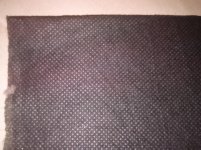
I do not know much about alternative materials as I haven't used any. Polyester (dacron / pillow foam) would be suitable and less hazardous during both handling / leakage situations. However, if you're planning on using foam, I think its cell structure (open / closed) needs to be considered first. You may want to hear from someone else who has successfully used any of those.
If the quantity of the leftover wool is sufficient, it may be best to take this opportunity to utilise it instead of having it in storage somewhere. Besides, if the box is closed there won't be any such issue.
Its from big old water heater, i have 3 panels 2x1m and many smaller pieces. I dont know the thickness tho.
From what i can see that alu bar where array baffle is located is open on both ends.
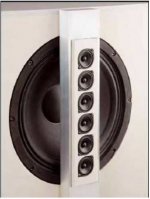
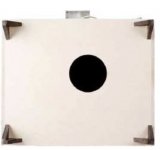
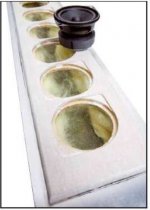
So should i use this glasswool for bass cabinet or array bar, or both ?
Im thinking of building array column out of wood entirely. I dont quite see benefit of aluminum over wood.
Aluminium and wood have entirely different properties when it comes to sound. The former, being a metal is more likely to transmit sound, which is something wood does not do very well.
What's the array baffle made of? Is there a separate enclosure specified for the array inside the tube?
Coming to damping, the woofer enclosure definitely needs a couple of inches of it. Also, since the 3rd picture in your previous post clearly shows some damping material for the array, it's best you do it as well.
Aluminium and wood have entirely different properties when it comes to sound. The former, being a metal is more likely to transmit sound, which is something wood does not do very well.
What's the array baffle made of? Is there a separate enclosure specified for the array inside the tube?
Coming to damping, the woofer enclosure definitely needs a couple of inches of it. Also, since the 3rd picture in your previous post clearly shows some damping material for the array, it's best you do it as well.
In original design a Alu profile 100x40x1000mm ; 3mm thickness.
Array baffle is MDF board 38x8mm ; 9mm thickness
It is connected via velcro tape to the front of cabinet, which is a great idea.
In text, which i translated with google translate from German, so who knows how correct it is. They say it wont matter much wood or aluminium. This way was faster. Just cut a hole in alu profile and slap a wooden baffle.
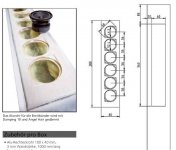
For cabinet itself, should i screw in the woofer baffle (450x450mm) or can it be glued somehow ? Woofer is around 3-4kg, i dont think its safe to just glue in baffle onto front board.
Im going to screw in all the edges of cabinet, thinking glue is bit weak to hold entire structure.
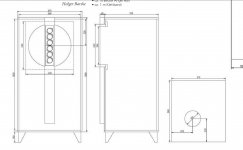
For woofer cabinet, im thinking of placing support beams on all corners, maybe 10x10mm and using this 10mm cavity to fill in with glasswool and enclose it with some soft fabric. Or.. just wrap glasswool in fabric and glue it to the walls of cabinet freehand.
Im thinking to dam all sides except bottom where bassreflex is and front panle where woofer baffle is. Or to add a layer to front panel aswell ?
Please see last picture in what i mean.
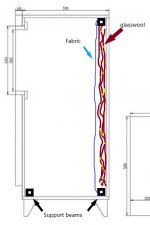
Last edited:
Well, in that case do as the design says. The blocks you mention would help the glue hold much better. Still, it is necessary to screw from both sides of a joint (in a staggered way) and seal it (with silicone etc.) to prevent leaks before adding damping. It would be sufficient if the larger area (back panel) alone is damped. However, try to give at least two inches of wool, irrespective of glue block thickness.
Also, since the strength of the front baffle is already compromised due to the large woofer cutout, some extra support would definitely help.
Also, since the strength of the front baffle is already compromised due to the large woofer cutout, some extra support would definitely help.
FWIW, historically, cheesecloth was loosely attached over the components and if vented, tightly stretched over the vent opening: Altec Heathkit legato 2-15 inch horn & driver
Interesting material, what is it?
Polyfill has been the norm for decades, though ground up denim has become popular in recent times: Home << Bonded Logic
Normally closed cell for LF, open for mids/HF.
edit: Historically, the top, one side and back are damped and only add some on the other side if it still sounds 'hollow' and/or increase the back panel thickness.
Interesting material, what is it?
Polyfill has been the norm for decades, though ground up denim has become popular in recent times: Home << Bonded Logic
Normally closed cell for LF, open for mids/HF.
edit: Historically, the top, one side and back are damped and only add some on the other side if it still sounds 'hollow' and/or increase the back panel thickness.
Last edited:
Re baffle construction, historically I've built a solid box to mount the driver to, then made a false baffle attached with small tabs of industrial Velcro to make the driver appear flush mounted.
Early on I used wood glue, screw blocks and blind screwing when required, but with the advent of PL400 floor, etc., construction adhesive, just glued and a few glued in wood/dowel scraps to further bond it.
Early on I used wood glue, screw blocks and blind screwing when required, but with the advent of PL400 floor, etc., construction adhesive, just glued and a few glued in wood/dowel scraps to further bond it.
glued in wood/dowel scraps to further bond it.
What exactly do you mean by this, from what i googled dowel's are those little wooden plugs. Do you make joints with them and hold everything without screws ?
And are you sure that industrial glue will hold it with together, i have never used it before.
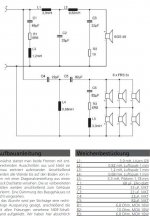
Regarding material, resistors are mox ceramic, caps are Visaton MKT-A polypropylene. Coils are air, FC and LR.
- Home
- Loudspeakers
- Multi-Way
- Help chosing high SPL drivers for 3way classic loudspeaker
